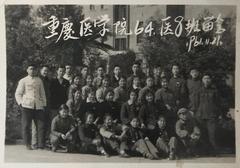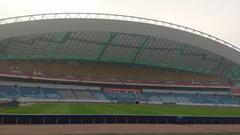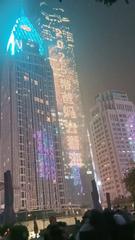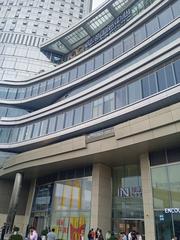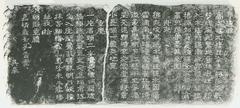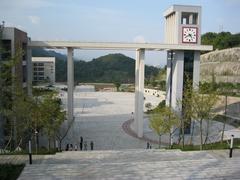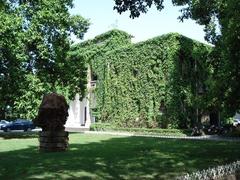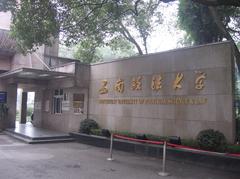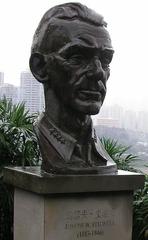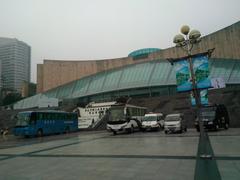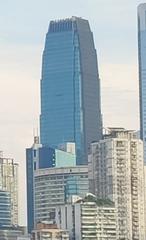Wanling Ancient Town, Chongqing: Visiting Hours, Tickets & Historical Sites Guide
Date: 15/06/2025
Introduction
Wanling Ancient Town, nestled in the eastern part of Chongqing’s Rongchang District, is a living testament to over 1,600 years of history and culture. Known as the “Little Mountain City,” Wanling captivates visitors with its harmonious blend of traditional Chinese architecture, scenic river landscapes, and enduring clan customs. As one of Chongqing’s premier historical sites, the town offers an immersive journey through ancient streets, vibrant markets, and local traditions that have been carefully preserved through the centuries. This guide provides detailed, up-to-date information on Wanling’s historical evolution, practical visitor tips, ticketing and hours, transportation, accessibility, cultural highlights, and nearby attractions—ensuring you enjoy a rewarding and authentic experience.
Table of Contents
- Introduction
- Historical Evolution
- Practical Visitor Information
- Cultural Significance
- Nearby Attractions
- Accommodation & Dining
- Practical Travel Tips
- Frequently Asked Questions (FAQ)
- Conclusion
- References
Historical Evolution of Wanling Ancient Town
Early Origins & Name Changes
Wanling’s origins trace back to the Eastern Jin Dynasty (326 AD), initially known as “Wanling.” During the Ming Dynasty, local folklore about monk Zeng Ao and six mysterious stone holes led to the alternate name “Lukong.” In 2013, historical research confirmed “Wanling” as the original name, leading to its restoration with overwhelming community support (Chongqing Historical Sites; ct-by.com).
Strategic Importance & Urban Layout
Wanling flourished in the Southern Song Dynasty as a key waterway hub, facilitating trade and tribute to the imperial court. Its four symbolic gates—Taiping, Shizi, Hengsheng, and Riyue—once guarded the town, reflecting prosperity and security. The town’s layout, built along the Laixi River and climbing the hillsides, creates a three-dimensional space that exemplifies the Chinese philosophy of harmony between humanity and nature (China Dragon Tours).
Architectural Heritage
The town features well-preserved Ming and Qing Dynasty architecture, including ancestral temples, academies, and traditional residences. Restoration projects have maintained the authenticity of structures like the Zhao Family Ancestral Temple and Er Ya Academy, while Yanyu Lane (“Misty Rain Lane”) has been recognized as one of Chongqing’s most beautiful alleys (Chongqing Historical Sites; ct-by.com).
Practical Visitor Information
Visiting Hours & Ticket Prices
- Opening Hours: 8:00 AM – 6:00 PM daily
- Admission: Commonly free; some exhibitions or performances (e.g., Sichuan Opera at Huaguang Guild Hall) may charge a small fee (10 RMB). Always check current information in advance as policies can change (Trip.com).
Accessibility & Travel Tips
- Terrain: Cobblestone streets and slopes; comfortable shoes are essential.
- Facilities: Modern amenities are limited within the historic core, but available in the surrounding district. Some accessible facilities exist, but mobility-impaired visitors should plan ahead.
- Tours: Daily guided tours are available and can be booked on-site or online. Cultural events and performances enrich the visit (ct-by.com).
Getting There & Local Transport
From Chongqing City Center:
- High-Speed Train: Chongqing West Railway Station → Rongchang North Station (1–1.5 hours), then local taxi/bus to Wanling Ancient Town.
- Bus: Intercity coaches from major Chongqing bus stations to Rongchang District (~2 hours), then local transfer.
- Car: About 2 hours’ drive via G85 Yinchuan-Kunming Expressway.
Local Transport:
- Extensive metro network in Chongqing for reaching transfer points (Yangtze River Cruises).
- Taxis and buses are widely available.
Cultural Significance
Clan Heritage & Intangible Customs
The Zhao Family Ancestral Temple (Qing Dynasty) remains a focal point for clan gatherings and ancestral worship. Traditional rituals, such as the nationally recognized “pig sacrifice,” highlight the town’s intangible heritage (Chongqing Historical Sites).
Festivals & Living Traditions
Wanling hosts vibrant festivals, folk performances, and Sichuan Opera shows. The lively markets and seasonal events provide an opportunity to experience authentic local culture first-hand.
Urban Aesthetics & Bayu Culture
Yanyu Lane’s poetic mist and stone-paved alleys epitomize the region’s atmosphere. Wanling is a repository of Bayu culture—marked by unique language, music, and folk arts—integrated into daily life and architecture (travelchinaguide.com).
Nearby Attractions
- Rongchang District: Known for marinated food and traditional crafts.
- Dazu Rock Carvings: UNESCO World Heritage Site, ~60 km NE, featuring intricate Buddhist, Taoist, and Confucian carvings (China Discovery).
- Ciqikou Ancient Town: Song Dynasty riverside town, accessible via metro (ChinaXianTour).
- Wulong Karst National Geological Park: Dramatic karst landscapes and caves, ~190 km SE (China Discovery).
- Hongya Cave & Chongqing City Sights: Neon-lit riverside complex, Three Gorges Museum, Jiefangbei CBD.
Accommodation & Dining
- Where to Stay: Guesthouses and hotels in Rongchang District provide easy access and comfort. Book in advance during peak seasons.
- Dining: Local specialties include spicy hotpot, marinated duck, and sweet rice cakes. Riverside eateries and street markets offer diverse options (Trip.com).
Practical Travel Tips
- Weather: Best to visit in spring (March–May) or autumn (September–November) for mild temperatures and vibrant scenery.
- Payments: Mobile payments (WeChat Pay, Alipay) are common; carry cash for small vendors.
- Language: Mandarin is standard; translation apps are useful for non-Chinese speakers.
- Connectivity: Wi-Fi is limited in the old town; consider a local SIM or portable device.
Frequently Asked Questions (FAQ)
Q: What are Wanling Ancient Town’s opening hours?
A: 8:00 AM to 6:00 PM daily.
Q: Is there an entry fee?
A: Generally free; some performances or exhibitions may charge a small fee.
Q: How do I reach Wanling from Chongqing?
A: High-speed train or bus to Rongchang District, then local taxi or bus.
Q: Are guided tours available?
A: Yes, onsite and online—recommended for historical and cultural insights.
Q: Is the town accessible for those with mobility challenges?
A: Some areas may be difficult due to cobblestones and slopes; plan accordingly.
Q: When is the best time to visit?
A: Spring and autumn for comfortable weather and fewer crowds.
Conclusion
Wanling Ancient Town is a vivid tapestry of Chongqing’s history and culture—offering ancient architecture, lively traditions, scenic beauty, and culinary delights. With practical visitor information, convenient transportation, and nearby attractions, it is an ideal destination for history enthusiasts, cultural explorers, and travelers seeking an authentic Chinese experience. To enrich your visit, download the Audiala app for guided tours, itineraries, and real-time updates.
References
- Wanling Ancient Town Visiting Hours, Tickets, and Historical Guide | Chongqing Historical Sites, 2025
- Wanling Ancient Town Visiting Hours, Tickets & Must-See Attractions in Chongqing, 2025
- Wanling Ancient Town Visiting Hours, Tickets, and Travel Guide to Chongqing’s Historic Site, 2025
- Wanling Ancient Town: Visiting Hours, Tickets, Transportation, and Nearby Attractions in Chongqing, 2025
- Dazu Rock Carvings Information, 2025
- Ciqikou Ancient Town Guide, 2025
- Yangtze River Cruises - Chongqing Transport Guide, 2025

